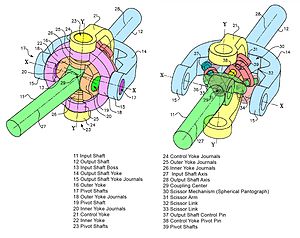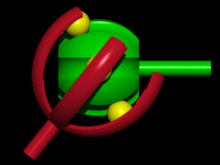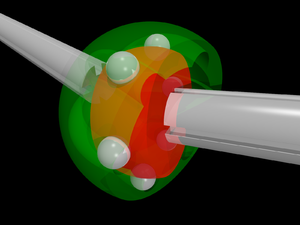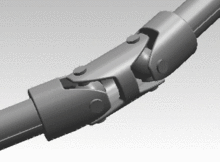- Constant-velocity joint
-
Constant-velocity joints (aka homokinetic or CV joints) allow a drive shaft to transmit power through a variable angle, at constant rotational speed, without an appreciable increase in friction or play. They are mainly used in front wheel drive and all wheel drive cars. Rear wheel drive cars with independent rear suspension typically use CV joints at the ends of the rear axle halfshafts, and increasingly use them on the propshafts. Audi Quattros use them for all four half-axles and on the front-to-rear driveshaft (propeller shaft) as well, for a total of ten CV joints.
Constant-velocity joints are protected by a rubber boot, a CV gaiter. Cracks and splits in the boot will allow contaminants in, which would cause the joint to wear quickly.
Contents
Before the CV joint
Early front wheel drive systems such as those used on the Citroën Traction Avant and the front axles of Land Rover and similar four wheel drive vehicles used universal joints, where a cross-shaped metal pivot sits between two forked carriers. These are not CV joints as, except for specific configurations, they result in a variation of the angular velocity. They are simple to make and can be tremendously strong, and are still used to provide a flexible coupling in some propshafts, where there is not very much movement. However, they become "notchy" and difficult to turn when operated at extreme angles, and need regular maintenance. They also need more complicated support bearings when used in drive axles, and could only be used in rigid axle designs.
The first CV joints
As front wheel drive systems became more popular, with cars such as the BMC Mini using compact transverse engine layouts, the shortcomings of universal joints in front axles became more and more apparent. Based on a design by Alfred H. Rzeppa which was filed for patent in 1927[1] (a CV joint, the Tracta joint, designed by Pierre Fenaille at Jean-Albert Grégoire's Tracta company was filed for patent in 1926[2]), constant velocity joints solved many of these problems. They allowed a smooth transfer of power despite the wide range of angles through which they were bent.
Rzeppa joints
A Rzeppa joint consists of a spherical inner with 6 grooves in it, and a similar enveloping outer shell. Each groove guides one ball. The input shaft fits in the centre of a large, steel, star-shaped "gear" that nests inside a circular cage. The cage is spherical but with ends open, and it typically has six openings around the perimeter. This cage and gear fit into a grooved cup that has a splined and threaded shaft attached to it. Six large steel balls sit inside the cup grooves and fit into the cage openings, nestled in the grooves of the star gear. The output shaft on the cup then runs through the wheel bearing and is secured by the axle nut. This joint can accommodate the large changes of angle when the front wheels are turned by the steering system; typical Rzeppa joints allow 45-48 degrees of articulation, while some can give 52 degrees. At the "outboard" end of the driveshaft a slightly different unit is used. The end of the driveshaft is splined and fits into the outer "joint". It is typically held in place by a circlip.
Tripod joints
These joints are used at the inboard end of car driveshafts. This joint has a three-pointed yoke attached to the shaft, which has barrel-shaped roller bearings on the ends. These fit into a cup with three matching grooves, attached to the differential. Since there is only significant movement in one axis, this simple arrangement works well. These also allow an axial 'plunge' movement of the shaft, so that engine rocking and other effects do not preload the bearings. A typical Tripod joint has up to 50 mm of plunge travel, and 26 degrees of angular articulation.[3]
Double Cardan
Double Cardan joints are similar to double Cardan shafts, except that the length of the intermediate shaft is shortened as much as is practical, effectively allowing the two Hooke's joints to be mounted back to back. DCJs are typically used in steering columns, as they eliminate the need to correctly phase the universal joints at the ends of the intermediate shaft (IS), which eases packaging of the IS around the other components in the engine bay of the car. They are also used to replace Rzeppa style constant-velocity joints in applications where high articulation angles, or impulsive torque loads are common, such as the driveshafts and halfshafts of rugged four wheel drive vehicles. Double Cardan joints have been developed utilizing a floating centering element[4] to maintain equal angles between the driven and driving shafts. This centering provides true constant velocity operation, but the torque required to accelerate the internals of the joint does generate some additional vibration at higher speeds.
Thompson coupling
 Thompson coupling from U.S. Patent 7,442,126. Note: drawing on the right omits certain components in order to illustrate the control yoke's spherical pantograph.
Thompson coupling from U.S. Patent 7,442,126. Note: drawing on the right omits certain components in order to illustrate the control yoke's spherical pantograph.
The Thompson constant velocity joint (TCVJ), also known as a Thompson coupling, is a constant velocity universal joint that can be loaded axially and continue to maintain constant velocity over a range of input and output shaft angles with low friction and vibration. It consists of two cardan joints assembled within each other, thus eliminating the intermediate shaft, along with a control yoke that geometrically constrains their alignment. The control yoke maintains equal joint angles between the input shafts and a relative phase angle of zero to ensure constant angular velocity at all input and output shaft angles. The control yoke employs a spherical pantograph scissor mechanism to bisect the angle between the input and output shaft. While the geometric configuration does not maintain constant velocity for the control yoke (aka intermediate coupling) aligning the cardan joints, the control yoke has minimal inertia and generates virtually no vibration. Eliminating the intermediate shaft and keeping the input shafts aligned in the homokinetic plane virtually eliminates the induced shear stresses and vibration inherent in traditional double cardan shafts.[5][6][7]
The use of cardan joints within the Thompson Coupling also reduces the wear, heat and friction[8] when compared with Rzeppa type constant velocity joints. Cardan joints, including Thompson couplings, utilise roller bearings running circumferentially, whereas Rzeppa constant velocity joints use balls which roll and slide axially along grooves. Continuous use of the Thompson Coupling at a straight-through, zero-degree angle causes excess wear and damage to the joint; a minimum offset of 2 degrees is recommended.[9]
The novel feature of the coupling is the method to geometrically constrain the pair of cardan joints within the assembly by using, for example, a spherical four bar scissors linkage (spherical pantograph) and it is the first coupling to have this combination of properties.[10]
The coupling earned its inventor, Glenn Thompson, the Australian Society for Engineering in Agriculture Engineering Award.[11]
Sigmadrive cv joint
There is a new type of constant velocity joint, recently patented, which allows both to transmit power from one tree to another that transmit forces pushing or pulling axial thrust or constant velocity joint is called SIGMADRIVE. It is used in the main take boats with propulsion system in-line as a vibration or angular correction.
- ^ Rzeppa, Alfred H. (1927). Universal Joint. US patent no. 1,665,280. http://v3.espacenet.com/origdoc?DB=EPODOC&IDX=US1665280&F=0&QPN=US1665280.
- ^ European Patent FR628309
- ^ GKN Driveline Driveshafts, gkndriveline.com.
- ^ Rzeppa Constant Velocity (CV) Joint
- ^ Sopanen, Jussi (1996). "Studies on Torsion Vibration of a Double Cardan Joint Driveline". http://www.ee.lut.fi/static/fi/lab/sahkokaytot/sameko/Cardan_Sameko.pdf. Retrieved 2008-01-22.
- ^ Sheu, P (2003-02-01). "Modelling and analysis of the Intermediate Shaft Between Two Universal Joints". http://cat.inist.fr/?aModele=afficheN&cpsidt=3004428. Retrieved 2008-01-22.
- ^ "The Thompson Coupling Joint mechanism in action". Thompson Couplings. http://www.youtube.com/watch?v=-tmvBwVPcSs. Retrieved 24 September 2011.
- ^ "Measurement of CV Joint Efficiency". 2005-02-10. http://www.ika.rwth-aachen.de/pdf_eb/gb5-14e_cv_joint_efficiency.pdf. Retrieved 2008-01-22.
- ^ "Extra Length 500Nm TCVJ". Thompson Couplings, Ltd.. http://www.thompsoncouplings.com/500Nm-AE-TCVJ-EL/Extra-Length-500Nm-TCVJ%28R%29/pd.php. Retrieved 25 September 2011. "Special Instructions: Continuous operation of the TCVJ coupling at 0 degrees is not recommended as this will cause excessive wear on bearings and cause damage to the coupling. For maximum efficiency and life of the TCVJ coupling, a minimum operating angle of 2.0 degrees is recommended."
- ^ Bowman, Rebecca (2006-08-03). "An invention to drive fuel costs down". yourguide.com.au. http://www.centralwesterndaily.com.au/news/local/news/general/an-invention-to-drive-fuel-costs-down/191341.aspx. Retrieved 2007-02-13.
- ^ Filmer, Mark (2003-11-13). "Invention generating interest". yourguide.com.au. http://www.centralwesterndaily.com.au/news/local/news/general/invention-generating-interest/360233.aspx. Retrieved 2007-02-13.
Categories:- Mechanisms
- Automotive transmission technologies
Wikimedia Foundation. 2010.



